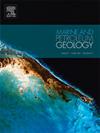Vegetation response to climatic evolution and environmental change during the Oligocene in the Bohai Bay Basin (eastern China): Implications of palynological and organic geochemical data
IF 3.7
2区 地球科学
Q1 GEOSCIENCES, MULTIDISCIPLINARY
引用次数: 0
Abstract
The Eocene-Oligocene transition was marked by a notable shift in global climate patterns, from greenhouse to icehouse conditions and continental aridification, consistent with a change in vegetation cover. Tectonic uplift and the collision between the Indian and Asian plates, as well as sea regression, were of the potential derivers of global climate changes. In the lacustrine Bohai Bay Basin, thick sequences of the siliciclastic Shahejie and Dongying formations were deposited during the Eocene-Oligocene. This study examines the Oligocene First Member (Es1) of the Shahejie Formation and the Third Member (Ed3) of the Dongying Formation from the NP3-20 well in the Nanpu Depression based on palynology, organic geochemistry, and mineralogical composition to reconstruct the paleoclimatic and paleoenvironmental conditions. Palynomorph composition reveals that the Es1 and Ed3 members are dominated by moderate to high abundances of gymnosperm and angiosperm pollen grains. Gymnosperms include mainly Pinaceae (Pinuspollenites and Piceaepollenites) and Podocarpaceae conifers (Podocarpidites and Paleoconiferus), which indicate cold-temperate conifer forests. Angiosperms, represented by Fagaceae (Quercoidites), Betulaceae (Betulaepollenites, Alnipollenites, and Momipites), Juglandaceae (Juglanspollenites and Caryapollenites), and Ulmaceae (Ulmipollenites and Ulmoideipites), suggest a broadleaved deciduous forest. These angiosperms together with fern spores reflect warm-temperate and humid climates typical of the lower vegetation belts in temperate and subtropical mountain ranges. Thus, the palynomorph content indicates that a mixed conifer and broadleaved deciduous forest was prevalent during deposition of the Oligocene Es1 and Ed3 members in the Nanpu Depression. This mixed forest is characterized by average annual temperatures of 2–8 °C and precipitation levels of 500–1000 mm, reflecting a temperate-warm and humid climate. Moderate acritarchs and rare dinoflagellate cysts suggest successive phases of marine incursions and increased hypersaline conditions during deposition of the Es1 and Ed3 members. Organic geochemical proxies, such as Pr/Ph, Pr/nC17, and Ph/nC18, provide further evidence of enhanced anoxia and increased marine organic matter input. The MPI and MPRs aromatic maturity parameters revealed that the Es1 and Ed3 members are thermally mature and reached the peak to late stages of the oil window. SARA analysis shows that most samples of the Es1 and Ed3 members rich in saturates, and the oils are normal paraffinic oils.
求助全文
约1分钟内获得全文
求助全文
来源期刊

Marine and Petroleum Geology
地学-地球科学综合
CiteScore
8.80
自引率
14.30%
发文量
475
审稿时长
63 days
期刊介绍:
Marine and Petroleum Geology is the pre-eminent international forum for the exchange of multidisciplinary concepts, interpretations and techniques for all concerned with marine and petroleum geology in industry, government and academia. Rapid bimonthly publication allows early communications of papers or short communications to the geoscience community.
Marine and Petroleum Geology is essential reading for geologists, geophysicists and explorationists in industry, government and academia working in the following areas: marine geology; basin analysis and evaluation; organic geochemistry; reserve/resource estimation; seismic stratigraphy; thermal models of basic evolution; sedimentary geology; continental margins; geophysical interpretation; structural geology/tectonics; formation evaluation techniques; well logging.
 求助内容:
求助内容: 应助结果提醒方式:
应助结果提醒方式:


